|
 Agrocybe erebia Agrocybe erebia
SynonymsAgaricus erebius
Pholiota erebia
BiostatusPresent in region - Origin uncertain
Images (click to enlarge)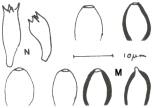
Caption: M. Basidiospores; N. Basidia | 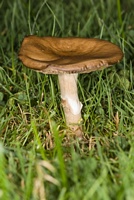
Owner: J.A. Cooper | 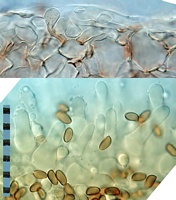
Caption: Top: section through cap surface. Lower: cheilocystidia.
Owner: J.A. Cooper | 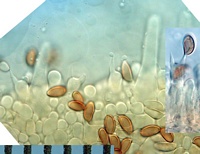
Caption: basidia and pleurocystidia
Owner: J.A. Cooper | 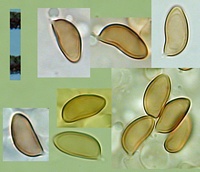
Caption: spores
Owner: J.A. Cooper | 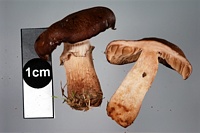
Owner: J.A. Cooper | 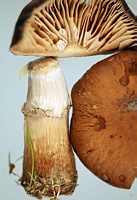
Owner: J.A. Cooper | 
Caption: 97-Agrocybe sp. [Pholiota erebia]: a. spores. | |
Article: Watling, R.; Taylor, G.M. (1987). Observations on the Bolbitiaceae: 27. Preliminary account of the Bolbitiaceae of New Zealand. Bibliotheca Mycologica 117: 61 p. + 17 pl.
Description: The microscopic characters which delimit A. erebia in Europe are: -
Basidiospores 9-13(-15) x (5-)6-7 µm, elongate elliptic in face-view, slightly boletoid in side-view, ochraceous in water and alkali; germ-pore absent. Basidia 2-spored, cylindric-clavate, hyaline. Cheilocystidia variable, vesiculose to ventricose even clavate, 30-60 x 8-25 µm, hyaline; pleurocystidia few to numerous, lageniform, 50-80 x 12-16 µm. apex obtuse, (4-) 6-9 µm broad, hyaline often granular punctate. Pileipellis a palisadoderm of balloon-shaped to pyriform cells 9-15 µm broad. Stipitipellis of filamentous hyphae supporting at stipe-apex sterile cells similar to the cheilocystidia. Clamp-connections apparently absent.
Notes: This was listed by Berkeley in Hooker's New Zealand Flora (1855) and Massee (1898) as Agaricus (Pholiota) erebius collected by Colenso from Ahuriri; the record should be accepted with some reservation, although it may indicate that this taxon is present in the New Zealand flora. Cunningham is purported to have collected this taxon at Weraroa (material in PDD) but this is a quite different fungus, and as much as we know about the collection is tabulated below. A. erebia should be looked out for under shrubs in gardens and parks, and if present is probably introduced.
Another closely related species but in too poor condition to determine occurred in a garden at Weraroa.
Article: Massee, G.E. (1899) [1898]. The fungus flora of New Zealand. Transactions and Proceedings of the New Zealand Institute 31: 282–349 Wellington:.
Description: Pileus convex, then flattened, glabrous, rather viscid, hygrophanous, margin striate, umber,
often with an olivaceous tinge, ochraceous-tan and often rugulose or wrinkled when dry, 2.5-5 cm. across; flesh thin, dingy;
gills adnate, rather distant, about 4 mm. broad, pallid, then
dingy-cinnamon; spores elliptical, 10-12 x 4-6 µ; stem about 5 cm. long, 6-8 mm. thick,
equal, somewhat striate, soon pale, hollow; ring, superior, soon pendulous, with the margin
upturned, more or less striate.
Habitat: On the ground.
Distribution: Ahuriri, Northern Island, New Zealand. Australia, Europe.
Notes: Distinguished by the dark-umber colour of the pileus when moist and the superior ring. The
pileus is sometimes more or less umbonate, at others slightly depressed; somewhat fragile.
Article: Horak, E. (1971). A contribution towards the revision of the Agaricales (Fungi) from New Zealand. New Zealand Journal of Botany 9(3): 403-462 (http://www.rsnz.org/publish/abstracts.php).
Notes: Fig. 7 A well developed annulus can still be observed on the carpophores of this
collection (N.Z.), but the spores are definitely different from those of Agrocybe
erebia. They have an obvious germ-pore, are thick-walled and measure 8.5-10 X
5.5-6.5 µ.
|